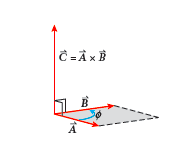Chapter 1. The cross product
10.1 – Introduction to the cross product
The dot product, described in the previous tutorial, is only one way to multiply two vectors. We can also multiply two vectors →A and →B using the cross product.
This operation is written as
→C=→A×→B
In the equation, the symbol “×” represents the mathematical operation known as the cross product.
Note: The result of taking the cross product of two vectors is another vector, whereas taking the dot product of two vectors (see tutorial 9) results in a scalar quantity.
The magnitude of the resulting vector from a cross product is equal to the product of the magnitudes of the two vectors and the sine of the angle between them.
So
C=|→A×→B|=ABsinϕ
The cross product of two vectors, →A and →B is always a vector perpendicular both →A and →B, as we can see in the picture:

The cross product is a vector →C that is perpendicular to both →A and →B, and has a magnitude AB sin ϕ, which equals the area of the parallelogram shown.
Note: The order of the two vectors in a cross product makes a difference. The cross product of →B and →A is the negative of the cross product of →A and →B or
→A×→B=−→B×→A
This results from the definition of the angle ϕ shown in the diagram - ϕ is directed from the first vector (→A) to the second vector (→B). If you travel the angle from the second vector to the first—in reverse direction, -ϕ becomes negative. The sine of a negative angle is also negative so calculating the cross product will give a negative answer.
Cross products are distributive, so →A×(→B+→C)=→A×→B+→A×→C
10.2 – Determining the direction of a cross product

a cross product - Take a
minute to practice this
for →A×→B and →B×→A. Do
you get opposite
directions for the →Cvector?
To determine the direction of the cross product
→C=→A×→B, you can use the right-hand rule.
How to do it:
1. Point the fingers of your right hand in the direction of the first vector of the cross product (in this case →A).
2. Then curl your fingers toward the second vector, →B. If you stick your thumb straight out, it points in the direction of the cross product, vector →C (the picture to the left may help).
If you instead want to find the direction of the cross product →B×→A, begin by pointing the fingers of your right hand in the direction of vector →B. Then curl them toward vector →A. Your thumb again points in the direction of the cross product.
Notice that using this method →A×→B gives the opposite direction to →B×→A as expected!
10.3 – The cross product – special cases
There are two special cases of the cross product that are worth pointing out.
1.The cross product of perpendicular vectors
In this case, the angle between the vectors, ϕ = 90°, so sin ϕ = 1
Therefore the magnitude of the cross product of perpendicular vectors is equal to:
|\overrightarrow{A} \times \overrightarrow{B}|=AB{\,}\mathtt{sin}{\,}90°=AB(1)=AB
2.The cross product of parallel vectors
In this case, the angle between the vectors, ϕ = 0°, so Sin ϕ = 0
Therefore the magnitude of the cross product of parallel vectors is equal to:
|\overrightarrow{A} \times \overrightarrow{B}|=AB{\,}\mathtt{sin}{\,}0=AB(0)=0
One example of this is the cross product of a vector with itself, \overrightarrow{A} \times \overrightarrow{A} = 0.
Try it yourself 1
Evaluate the magnitude of the following cross products,
Question Sequence
Question 1.
\overrightarrow{A} \times \overrightarrow{B}, where \overrightarrow{A} is a vector of magnitude, 3 in the x direction and \overrightarrow{B} is a vector of magnitude 5 in the y direction.
Worked Example
Try it yourself 2
Question Sequence
Question 4.
For Questions 4-8:
Vector \overrightarrow{A} has components, Ax = 2, Ay = 2, Az = 0
Vector \overrightarrow{B} has components Bx = 7, By = 0, Bz = 0
What is the magnitude of vector \overrightarrow{A}?